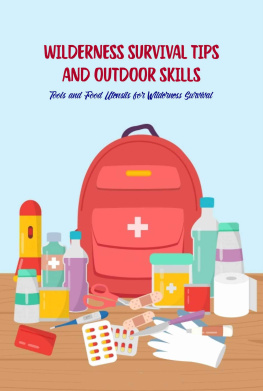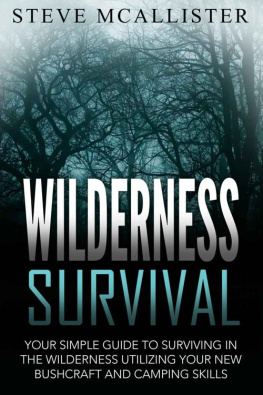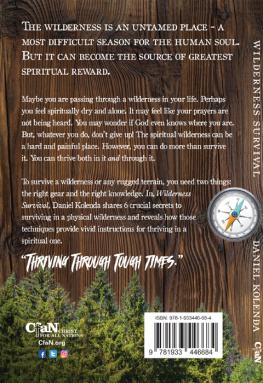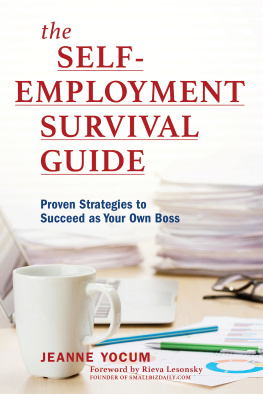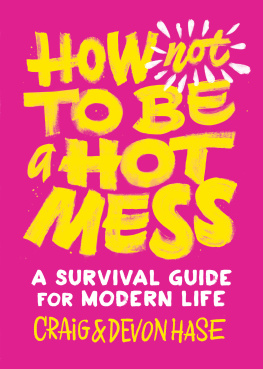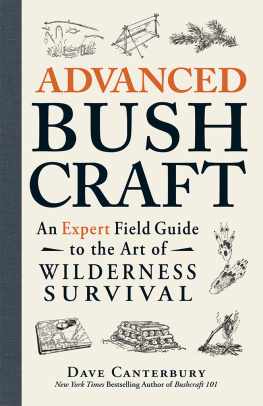Chappelow Craig - The Toxic Boss Survival Guide - Tactics for Navigating the Wilderness at Work
Here you can read online Chappelow Craig - The Toxic Boss Survival Guide - Tactics for Navigating the Wilderness at Work full text of the book (entire story) in english for free. Download pdf and epub, get meaning, cover and reviews about this ebook. year: 2018, publisher: Center for Creative Leadership, genre: Romance novel. Description of the work, (preface) as well as reviews are available. Best literature library LitArk.com created for fans of good reading and offers a wide selection of genres:
Romance novel
Science fiction
Adventure
Detective
Science
History
Home and family
Prose
Art
Politics
Computer
Non-fiction
Religion
Business
Children
Humor
Choose a favorite category and find really read worthwhile books. Enjoy immersion in the world of imagination, feel the emotions of the characters or learn something new for yourself, make an fascinating discovery.
- Book:The Toxic Boss Survival Guide - Tactics for Navigating the Wilderness at Work
- Author:
- Publisher:Center for Creative Leadership
- Genre:
- Year:2018
- Rating:4 / 5
- Favourites:Add to favourites
- Your mark:
- 80
- 1
- 2
- 3
- 4
- 5
The Toxic Boss Survival Guide - Tactics for Navigating the Wilderness at Work: summary, description and annotation
We offer to read an annotation, description, summary or preface (depends on what the author of the book "The Toxic Boss Survival Guide - Tactics for Navigating the Wilderness at Work" wrote himself). If you haven't found the necessary information about the book — write in the comments, we will try to find it.
Chappelow Craig: author's other books
Who wrote The Toxic Boss Survival Guide - Tactics for Navigating the Wilderness at Work? Find out the surname, the name of the author of the book and a list of all author's works by series.
The Toxic Boss Survival Guide - Tactics for Navigating the Wilderness at Work — read online for free the complete book (whole text) full work
Below is the text of the book, divided by pages. System saving the place of the last page read, allows you to conveniently read the book "The Toxic Boss Survival Guide - Tactics for Navigating the Wilderness at Work" online for free, without having to search again every time where you left off. Put a bookmark, and you can go to the page where you finished reading at any time.
Font size:
Interval:
Bookmark:

THE
TOXIC
BOSS
SURVIVAL
GUIDE

THE
TOXIC
BOSS
SURVIVAL
GUIDE
TACTICS FOR NAVIGATING THE WILDERNESS AT WORK
Craig Chappelow | Peter Ronayne | Bill Adams

LEAD CONTRIBUTORS
Craig Chappelow Peter Ronayne Bill Adams
CONTRIBUTORS
Reggie Bennett, Mike Figliuolo, Donnie Horner, Harold Scharlatt, Stevie Toepke
DIRECTOR, PEOPLE, PROCESS, PRODUCTS
Davida Sharpe
MANAGER, PUBLICATION DEVELOPMENT
Peter Scisco
EDITOR
Shaun Martin
DESIGN AND ILLUSTRATIONS
Diana Coe
RIGHTS AND PERMISSIONS
Kelly Lombardino
EDITORIAL BOARD
David Altman, Elaine Biech, Regina Eckert, Joan Gurvis, Jennifer Habig, Kevin Liu, Neal Maillet, Jennifer Martineau, Portia Mount, Laura Santana
Copyright 2018 Center for Creative Leadership
All Rights Reserved. No part of this publication may be reproduced, stored in a retrieval system, or transmitted, in any form or by any means, electronic, mechanical, photocopying, recording, or otherwise, without the prior written permission of the publisher. Printed in the United States of America.
CCL No. 001007
978-1-60491-763-5 Print
978-1-60491-764-2 Ebook
Cataloging in publication data on file with the Library of Congress.
CONTENTS
AUTHORS NOTE: BEYOND TOXIC
It was a stop the press moment. Hours before this book was printed, multiple allegations of sexual misconduct in entertainment, media, business, and political workplaces exploded into the public conversation. In the days that followed it was clear to us that we were witnessing a watershed event. Rather than one or two stories that spur handwringing and are then swept from the front page or disappear from the evening news, scores of stories poured out from multiple sourcesmany of them women in powerful positions who described being victims of sexual misconductfrom harassment to assault. The six types of toxic bosses we discuss in this book cause much grief and misery. But sexual misconduct is beyond toxic: its unethical, immoral, and in some cases illegal. And, from the outset, was beyond the scope of this book.
When we started this project, the authors agreed to stay true to what we discovered from our toxic boss survey. The group that participated in our survey broke almost evenly between men (51%) and women (49%). Only one response was even close to describing sexual misconduct: sexist. Why were bosses guilty of sexual misconduct left out? We arent sure, but we have some theories. For one thing, if we conducted the same study now, people might be more willing to step forward with examples of sexual misconduct because the climate for discussion has opened. Second, its possible that the survey participants interpreted sexual misconduct as fundamentally different from lousy management. Third, a survey like this one might not be the place one would reveal painful or personal information.
The six toxic types we discuss in this book dont include criminal acts. Assault, fraud, and other destructive acts create toxic environments, but the focus of this book, based on our survey, is limited to bad management and poor leadership. In terms of sexual misconduct against women, we direct our readers to www.ccl.org/womenleadership to review the substantial amount of work that CCL had completed over the years pertaining to women in leadership. Some of that work appears in books, such as Standing at the Crossroads and the forthcoming Kick Some Glass. Other work is reported in research reports and white papers. And a good deal of CCLs work about women in leadership drives our design of classroom experiences, such as the Womens Leadership Experience and the Technical Womens Leadership Journey.
We believe that #metoo and #timesup place organizations at a tipping point. While there is no vaccine against toxic leadership, powerful and far-reaching conversations about sexual misconductas well as increased scrutiny of organizations that protect the perpetratorsare redefining how we think of leadership and forcing organizations to take action. And for readers suffering under the thumbs of the toxic bosses we describe in this book, we hope that the strategies and tactics we provide help you survive your own toxic circumstances.
ACKNOWLEDGMENTS
Our thanks to the members of the Center for Creative Leaderships Leading Insights Community for their toxic boss stories. Thanks to Paula Morrow for managing the responses, to Jonathan Vehar for his ideas, to Kathy Schaftlein for her insights, and to Kris Downing for her suggestions. And special thanks to Harold Scharlatt, Mike Figliuolo, Donnie Horner, and Stevie Toepke for their insightful and valuable feedback on this book.
PREFACE
If you are standing in a bookstore flipping through this book or checking it out online, chances are you are in pain. If so, you already know what its like to work for a toxic boss. You know they suck the air out of a room and the life out of their employees, and you dont need a research report to tell you that working for one is a nightmare. If this sounds like your current reality and you want help, this book is for you. Just know that it is not the kind of book that will mince words, make everyone happy, or jump-start the authors status as leadership gurus. It is intended to be a practical, boots-on-the-ground guide to help you understand your situation and survive your toxic boss. So grab it and hunker down in the boss-proof bunker you built and get started. You can do this.
All three of the authors are toxic boss survivors. We lived to tell about it, but we lacked some critical survival knowledge and tactics that would have helped us immeasurably. In our work at the Center for Creative Leadership (CCL), we have met and worked with thousands of leaders and managers from around the world and from all kinds of companies, government organizations, nonprofits, and educational institutions. When the , the discussion leaves behind any in-class formality and the participants, male and female, young and old, will regularly share that they currently work for, or have previously worked for, an asshole. Our program participants are not whiners, and they dont fear challenges. Most are pros who have built a track record of success, and all of them have faced some degree of hardship over the course of their careers. And, for the most part, they have worked their way through the hardship by focusing on the issue, working harder, being flexible, and in the case of interpersonal conflict, working openly and honestly with the other personto work it out together. But if you find yourself working for a truly toxic boss, none of that works. Toxicity isnt cured with carefully crafted feedback or through some kind of a win-win scenario where everyone comes out a better person. The bar conversations invariably ended up as a nightmare saga ending with a survival story. What people really want, we discovered, is a toxic boss survival guide.
The objective for any guide like this one, whether written for the business world, the military, worst-case scenarios, or even a zombie apocalypse, is to help you face your challenge realistically, identify the tools available to you, and deal with the problem. Our aim is to help you analyze your immediate situation, create a workable survival plan that fits your situation, and carry it out (including abandoning the situation, if that is what it takes to survive).
Next pageFont size:
Interval:
Bookmark:
Similar books «The Toxic Boss Survival Guide - Tactics for Navigating the Wilderness at Work»
Look at similar books to The Toxic Boss Survival Guide - Tactics for Navigating the Wilderness at Work. We have selected literature similar in name and meaning in the hope of providing readers with more options to find new, interesting, not yet read works.
Discussion, reviews of the book The Toxic Boss Survival Guide - Tactics for Navigating the Wilderness at Work and just readers' own opinions. Leave your comments, write what you think about the work, its meaning or the main characters. Specify what exactly you liked and what you didn't like, and why you think so.





